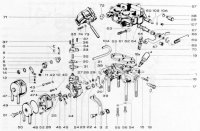After adjusting the carbs to the best of my ability following all the sage advice on the board, we promptly went on a 1,000 mile circumnavigation (almost) of Lake Michigan as part of an event with the BMWCCA. The car performed very, very well and I had plenty of seat time to further diagnose any remaining flaws in my tuning.
There still is slight and short-lived hesitation in the transition from throttle plate just a bit open to opening it fully. It was noticeable if at highway speeds I would completely lift off, then slowly start pressing down on the accelerator and it would happen after pressing down on the pedal just a little (maybe less than 1cm) but not as soon as I pressed. So it happens I think as the tiny openings, above the main idle opening, in the barrel start getting exposed. I cleaned those and I know they were flowing well (test with compressed air after cleaning). And I think my idle screw is turned out past 2 turns which I thinks makes it pretty rich. Both accelerator pumps were working well when I put the carbs back together but I didn't measure the output in cc, lacking that cute little curvy cup. Could this be it?
Other than that, the throttle response is phenomenal. It responds strongly and WOT application is a real trip with all swooshing air sounds emanating from up front. :-D
Speaking of sounds, the original fan clutch and red fan are working just fine and I can clearly hear when the fan is engaging and disengaging almost as if an electric fan that is turning on and off. You can clearly hear the fan sound (with windows open).
Does anyone have a photo of the phenolic spacer with the o-ring installed on the idle mix hole? Is it two o-rings one on each side of the spacer?

